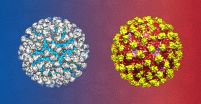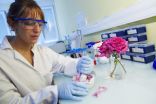Study shows novel HIV vaccine regimen provides robust protection in non-human primates
2015-07-02
(Press-News.org) BOSTON -- A new study led by scientists at Beth Israel Deaconess Medical Center (BIDMC) shows that an HIV-1 vaccine regimen, involving a viral vector boosted with a purified envelope protein, provided complete protection in half of the vaccinated non-human primates (NHPs) against a series of six repeated challenges with simian immunodeficiency virus (SIV), a virus similar to HIV that infects NHPs. These findings are published online today in Science.
Based on these pre-clinical data, the HIV-1 version of this vaccine regimen is now being evaluated in an ongoing Phase 1/2a international clinical study sponsored by Crucell Holland B.V., one of the Janssen Pharmaceutical Companies of Johnson & Johnson.
"We previously showed that adenovirus vector-based HIV-1 vaccine candidates offered partial protection against SIV when given alone," said lead author Dan H. Barouch, M.D., Ph.D., director of the Center for Virology and Vaccine Research at BIDMC and professor of medicine at Harvard Medical School. The paper describes two new studies in which investigators evaluated the protective efficacy of an adenovirus serotype 26 (Ad26) vectored vaccine boosted with a purified envelope protein.
The results demonstrate that viral vector priming plus protein boosting resulted in complete protection in half of the vaccinated animals. "This shows improvement over our previous results," said Barouch, who is also a steering committee member of the Ragon Institute of MGH, MIT, and Harvard. "Moreover, protection correlated with the magnitude and polyfunctionality of antibody responses. The data show the potential utility of envelope protein boosting following Ad26 priming."
"Bringing the global HIV epidemic under control requires new tools, bold strategies and collaboration among a number of stakeholders," said Hanneke Schuitemaker, one of the study authors and vice president, Viral Vaccines Discovery and Translational Medicine, Janssen. "In line with our company's commitment to address global health needs, we are committed to working with leading experts to develop a preventative HIV vaccine and our team is excited to advance this program into human clinical studies."
INFORMATION:
This study was supported by the following grants from the National Institutes of Health: AI060354; AI078526; AI0080280; AI084794; AI095985; AI096040; AI102660; AI102691; OD011170; HHSN261200300001E, as well as funding from the Bill & Melinda Gates Foundation, and the Ragon Institute of MGH, MIT, and Harvard.
In addition to Barouch and Schuitemaker, co-authors include BIDMC investigators Erica N. Borducchi, Kaitlin M. Smith, Joseph P. Nkolola, Jinyan Liu, Jennifer Shields, Lily Parenteau, James B. Whitney, Peter Abbink, David M. Ng'ang'a, Michael S. Seaman, Christy L. Lavine, and James R. Perry; Galit Alter, Thomas Broge, and Caitlyn Linde of the Ragon Institute of MGH, MIT, and Harvard; Margaret E. Ackerman and Eric P. Brown of the Thayer School of Engineering at Dartmouth; Wenjun Li of the University of Massachusetts Medical School; Arnaud D. Colantonio; Mark G. Lewis of Bioqual; Bing Chen, of Boston Children's Hospital; Holger Wenschuh and Ulf Reimer of JPT Peptide Technologies GmbH; Michael Piatak and Jeffrey D. Lifson of the AIDS and Cancer Program, Leidos Biomedical Research, Frederick National Laboratory; Scott A. Handley, and Herbert W. Virgin of Washington University School of Medicine; Marguerite Koutsoukos, Clarisse Lorin, and Gerald Voss of GSK Vaccines; and Mo Weijtens and Maria G. Pau of Janssen.
Beth Israel Deaconess Medical Center is a patient care, teaching and research affiliate of Harvard Medical School and consistently ranks as a national leader among independent hospitals in National Institutes of Health funding.
BIDMC is in the community with Beth Israel Deaconess Hospital-Milton, Beth Israel Deaconess Hospital-Needham, Beth Israel Deaconess Hospital-Plymouth, Anna Jaques Hospital, Cambridge Health Alliance, Lawrence General Hospital, Signature Healthcare, Beth Israel Deaconess HealthCare, Community Care Alliance and Atrius Health. BIDMC is also clinically affiliated with the Joslin Diabetes Center and Hebrew Rehabilitation Center and is a research partner of Dana-Farber/Harvard Cancer Center and The Jackson Laboratory. BIDMC is the official hospital of the Boston Red Sox. For more information, visit http://www.bidmc.org.
ELSE PRESS RELEASES FROM THIS DATE:
2015-07-02
One more piece and we are done! A research team led by the Duke-NUS Graduate Medical School Singapore (Duke-NUS) has found the second-to-last piece of the puzzle needed to potentially cure or treat dengue. This is welcome news as the dengue virus infects about 400 million people worldwide annually, and there is currently no licensed vaccine available to treat it.
Associate Professor Shee-Mei Lok and Research Fellow Guntur Fibriansah, from the Duke-NUS Emerging Infectious Diseases (EID) Programme, led research that showed how an antibody neutralises dengue virus serotype ...
2015-07-02
In a new Science study, Duke-NUS Graduate Medical School Singapore (Duke-NUS) scientists have identified how small changes in dengue's viral genome can affect the virus' ability to manipulate human immune defences and spread more efficiently. This research is the first of its kind that examined the dengue virus starting from broad population level observations and then linked it to specific molecular interactions, to explain an outbreak. This work provides a framework for identifying genomic differences within the virus that are important for epidemic spread.
Dengue virus ...
2015-07-02
This news release is available in Japanese. Detailed tabletop experiments are helping researchers understand how Earth's landscapes erode to form networks of hills and valleys. The findings, which highlight a balance between processes that send sediments down hills and those that wash them out of valleys, might also help researchers predict how climate change could transform landscapes in the future. Kristin Sweeney and colleagues developed a laboratory device that mimicked the processes that smooth or disturb soil to make hillslopes, and those that cut it away to make ...
2015-07-02
This news release is available in Japanese. Researchers have discovered that a human antibody specific to dengue virus serotype 2, called 2D22, protects mice from a lethal form of the virus -- and they suggest that the site where 2D22 binds to the virus could represent a potential vaccine target. The mosquito-borne virus, which infects nearly 400 million people around the world each year, has four distinct serotypes, or variations, and there is currently no protective vaccine available. Recent phase 3 clinical trials of a potential vaccine candidate showed poor efficacy, ...
2015-07-02
Why is the seahorse's tail square? An international team of researchers has found the answer and it could lead to building better robots and medical devices. In a nutshell, a tail made of square, overlapping segments makes for better armor than a cylindrical tail. It's also better at gripping and grasping. Researchers describe their findings in the July 3 issue of Science.
"Almost all animal tails have circular or oval cross-sections--but not the seahorse's. We wondered why," said Michael Porter, an assistant professor in mechanical engineering at Clemson University and ...
2015-07-02
This news release is available in Japanese. Researchers working with roses have identified an enzyme, known as RhNUDX1, which plays a key role in producing the flowers' sweet fragrances. These ornamental plants, which provide essential oils for perfumes and cosmetics, have been bred mostly for their visual traits, and their once-strong scents have faded over the generations. Restoring their fragrant odors will require a better understanding of the rose scent biosynthesis pathway. Until now, most studies of rose fragrance have focused on a biosynthetic pathway that generates ...
2015-07-02
This news release is available in Japanese. The seahorse tail is square because this shape is better at resisting damage and at grasping than a circular tail would be, a new engineering study shows. Insights gleaned from the study could inspire new armor and advances in robotics, the authors say. While most animals with tails, including certain monkeys, lizards and rodents, have soft, cylindrical-shaped appendages, tails of seahorses are organized into square prisms surrounded by bony plates. To better understand why the seahorse tail deviates from the norm, and what ...
2015-07-02
Mass killings and school shootings in the U.S. appear to be contagious, according to a team of scientists from Arizona State University and Northeastern Illinois University.
Study author Sherry Towers, research professor in the ASU Simon A. Levin Mathematical, Computational and Modeling Sciences Center, explained, "The hallmark of contagion is observing patterns of many events that are bunched in time, rather than occurring randomly in time."
Her team examined databases on past high-profile mass killings and school shootings in the U.S. and fit a contagion model to ...
2015-07-02
Climate change is forcing fish out of their current habitats and into cooler waters and many more species will soon be affected if climate goals are not met, say scientists.
An international team of researchers compared the future of the oceans under two climate change scenarios. In one scenario, we limit atmospheric warming to two degrees by 2100, as outlined by the Copenhagen accord. In the other, we continue with the current approach, which researchers say would cause a five-degree increase in atmospheric temperatures. They say if warming continues unchecked, fish ...
2015-07-02
A new study has discovered mysterious behaviour of a material that acts like an insulator in certain measurements, but simultaneously acts like a conductor in others. In an insulator, electrons are largely stuck in one place, while in a conductor, the electrons flow freely. The results, published today (2 July) in the journal Science, challenge current understanding of how materials behave.
Conductors, such as metals, conduct electricity, while insulators, such as rubber or glass, prevent or block the flow of electricity. But by tracing the path that electrons follow ...
LAST 30 PRESS RELEASES:
[Press-News.org] Study shows novel HIV vaccine regimen provides robust protection in non-human primates




